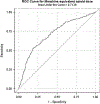A Detailed Exploration Into the Association of Prescribed Opioid Dosage and Overdose Deaths Among Patients With Chronic Pain
- PMID: 26807540
- PMCID: PMC6626611
- DOI: 10.1097/MLR.0000000000000505
A Detailed Exploration Into the Association of Prescribed Opioid Dosage and Overdose Deaths Among Patients With Chronic Pain
Abstract
Background: High opioid dosage has been associated with overdose, and clinical guidelines have cautioned against escalating dosages above 100 morphine-equivalent mg (MEM) based on the potential harm and the absence of evidence of benefit from high dosages. However, this 100 MEM threshold was chosen somewhat arbitrarily.
Objective: To examine the association of prescribed opioid dosage as a continuous measure in relation to risk of unintentional opioid overdose to identify the range of dosages associated with risk of overdose at a detailed level.
Methods: In this nested case-control study with risk-set sampling of controls, cases (opioid overdose decedents) and controls were identified from a population of patients of the Veterans Health Administration who were prescribed opioids and who have a chronic pain diagnosis. Unintentional fatal opioid analgesic overdose was measured from National Death Index records and prescribed opioid dosage from pharmacy records.
Results: The average prescribed opioid dosage was higher (P<0.001) for cases (mean=98.1 MEM, SD=112.7; median=60, interquartile range, 30-120), than controls (mean=47.7 MEM, SD=65.2; median=25, interquartile range, 15-45). In a ROC analysis, dosage was a moderately good "predictor" of opioid overdose death, indicating that, on average, overdose cases had a prescribed opioid dosage higher than 71% of controls.
Conclusions: A clear cut-point in opioid dosage to distinguish between overdose cases and controls was not found. However, lowering the recommended dosage threshold below the 100 MEM used in many recent guidelines would affect proportionately few patients not at risk for overdose while potentially benefitting many of those at risk for overdose.
Conflict of interest statement
The authors declare no conflict of interest.
Figures



Comment in
-
Responding to America's Iatrogenic Epidemic of Prescription Opioid Addiction and Overdose.Med Care. 2016 May;54(5):426-9. doi: 10.1097/MLR.0000000000000537. Med Care. 2016. PMID: 27075900 No abstract available.
References
-
- Paulozzi LJ, Weisler RH, Patkar AA. A national epidemic of unintentional prescription opioid overdose deaths: how physicians can help control it. J Clin Psychiatry. 2011;72:589–592. - PubMed
-
- Hall AJ, Logan JE, Toblin RL, et al. Patterns of abuse among unintentional pharmaceutical overdose fatalities. JAMA. 2008;300: 2613–2620. - PubMed
-
- Okie S A flood of opioids, a rising tide of deaths. N Engl J Med. 2010;363:1981–1985. - PubMed
-
- Nelson LS, Juurlink DN, Perrone J. Addressing the opioid epidemic. JAMA. 2015;314:1453–1454. - PubMed
-
- Bohnert AS, Valenstein M, Bair MJ, et al. Association between opioid prescribing patterns and opioid overdose-related deaths. JAMA. 2011;305:1315–1321. - PubMed
Publication types
MeSH terms
Substances
Grants and funding
LinkOut - more resources
Full Text Sources
Other Literature Sources
Medical

